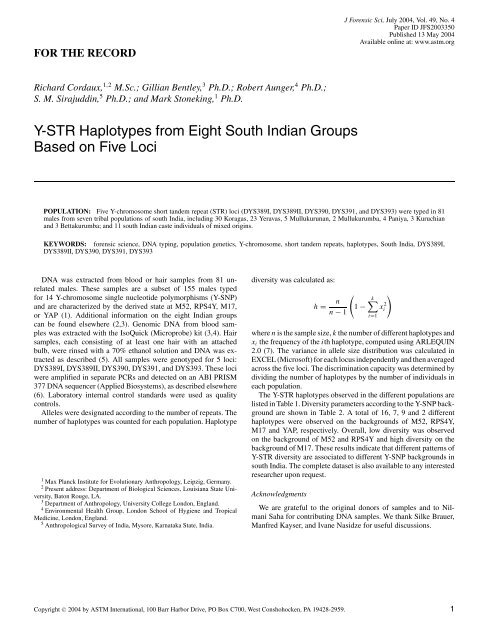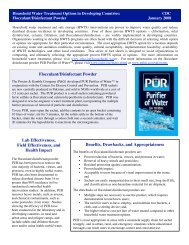Y-STR Haplotypes from Eight South Indian ... - Hygiene Central
Y-STR Haplotypes from Eight South Indian ... - Hygiene Central
Y-STR Haplotypes from Eight South Indian ... - Hygiene Central
Create successful ePaper yourself
Turn your PDF publications into a flip-book with our unique Google optimized e-Paper software.
FOR THE RECORD<br />
JForensic Sci, July 2004, Vol. 49, No. 4<br />
Paper ID JFS2003350<br />
Published 13 May 2004<br />
Available online at: www.astm.org<br />
Richard Cordaux, 1,2 M.Sc.; Gillian Bentley, 3 Ph.D.; Robert Aunger, 4 Ph.D.;<br />
S. M. Sirajuddin, 5 Ph.D.; and Mark Stoneking, 1 Ph.D.<br />
Y-<strong>STR</strong> <strong>Haplotypes</strong> <strong>from</strong> <strong>Eight</strong> <strong>South</strong> <strong>Indian</strong> Groups<br />
Based on Five Loci<br />
POPULATION: Five Y-chromosome short tandem repeat (<strong>STR</strong>) loci (DYS389I, DYS389II, DYS390, DYS391, and DYS393) were typed in 81<br />
males <strong>from</strong> seven tribal populations of south India, including 30 Koragas, 23 Yeravas, 5 Mullukurunan, 2 Mullukurumba, 4 Paniya, 3 Kuruchian<br />
and 3 Bettakurumba; and 11 south <strong>Indian</strong> caste individuals of mixed origins.<br />
KEYWORDS: forensic science, DNA typing, population genetics, Y-chromosome, short tandem repeats, haplotypes, <strong>South</strong> India, DYS389I,<br />
DYS389II, DYS390, DYS391, DYS393<br />
DNA was extracted <strong>from</strong> blood or hair samples <strong>from</strong> 81 unrelated<br />
males. These samples are a subset of 155 males typed<br />
for 14 Y-chromosome single nucleotide polymorphisms (Y-SNP)<br />
and are characterized by the derived state at M52, RPS4Y, M17,<br />
or YAP (1). Additional information on the eight <strong>Indian</strong> groups<br />
can be found elsewhere (2,3). Genomic DNA <strong>from</strong> blood samples<br />
was extracted with the IsoQuick (Microprobe) kit (3,4). Hair<br />
samples, each consisting of at least one hair with an attached<br />
bulb, were rinsed with a 70% ethanol solution and DNA was extracted<br />
as described (5). All samples were genotyped for 5 loci:<br />
DYS389I, DYS389II, DYS390, DYS391, and DYS393. These loci<br />
were amplified in separate PCRs and detected on an ABI PRISM<br />
377 DNA sequencer (Applied Biosystems), as described elsewhere<br />
(6). Laboratory internal control standards were used as quality<br />
controls.<br />
Alleles were designated according to the number of repeats. The<br />
number of haplotypes was counted for each population. Haplotype<br />
1 Max Planck Institute for Evolutionary Anthropology, Leipzig, Germany.<br />
2 Present address: Department of Biological Sciences, Louisiana State University,<br />
Baton Rouge, LA.<br />
3 Department of Anthropology, University College London, England.<br />
4 Environmental Health Group, London School of <strong>Hygiene</strong> and Tropical<br />
Medicine, London, England.<br />
5 Anthropological Survey of India, Mysore, Karnataka State, India.<br />
diversity was calculated as:<br />
h =<br />
(<br />
n 1 −<br />
n − 1<br />
k∑<br />
xi<br />
2<br />
i=1<br />
where n is the sample size, k the number of different haplotypes and<br />
x i the frequency of the ith haplotype, computed using ARLEQUIN<br />
2.0 (7). The variance in allele size distribution was calculated in<br />
EXCEL (Microsoft) for each locus independently and then averaged<br />
across the five loci. The discrimination capacity was determined by<br />
dividing the number of haplotypes by the number of individuals in<br />
each population.<br />
The Y-<strong>STR</strong> haplotypes observed in the different populations are<br />
listed in Table 1. Diversity parameters according to the Y-SNP background<br />
are shown in Table 2. A total of 16, 7, 9 and 2 different<br />
haplotypes were observed on the backgrounds of M52, RPS4Y,<br />
M17 and YAP, respectively. Overall, low diversity was observed<br />
on the background of M52 and RPS4Y and high diversity on the<br />
background of M17. These results indicate that different patterns of<br />
Y-<strong>STR</strong> diversity are associated to different Y-SNP backgrounds in<br />
south India. The complete dataset is also available to any interested<br />
researcher upon request.<br />
Acknowledgments<br />
We are grateful to the original donors of samples and to Nilmani<br />
Saha for contributing DNA samples. We thank Silke Brauer,<br />
Manfred Kayser, and Ivane Nasidze for useful discussions.<br />
)<br />
Copyright C○ 2004 by ASTM International, 100 Barr Harbor Drive, PO Box C700, West Conshohocken, PA 19428-2959. 1
2 JOURNAL OF FORENSIC SCIENCES<br />
TABLE 1—Y-<strong>STR</strong> haplotypes <strong>from</strong> 81 south <strong>Indian</strong> males based on five loci and classified according to Y-SNP background.<br />
Y-SNP<br />
Caste<br />
Background DYS389I DYS389II DYS390 DYS391 DYS393 Yeravas Bettakurumba Koragas Mullukurumba Mullukurunan Kuruchian Paniya group TOTAL<br />
M52 9 17 22 10 12 2 - - - - - - - 2<br />
M52 9 17 23 10 12 1 - - - - - - - 1<br />
M52 10 16 21 10 12 - - - - - - - 1 1<br />
M52 10 16 22 10 12 - 1 6 1 - - - - 8<br />
M52 10 16 22 11 12 - - - - 2 - - 1 3<br />
M52 10 16 23 10 12 - 1 - - 1 1 - - 3<br />
M52 10 16 23 11 12 - - - - 1 - - - 1<br />
M52 10 17 22 10 12 5 - 2 1 - - 1 - 9<br />
M52 10 18 22 10 12 - - 2 - - - - - 2<br />
M52 11 16 21 10 12 - - - - - - - 1 1<br />
M52 11 16 21 11 12 - - 1 - - - - - 1<br />
M52 11 16 22 10 12 - - 10 - - - - 1 11<br />
M52 11 16 22 11 12 - - 5 - - - - - 5<br />
M52 11 16 23 10 12 - - 1 - - - - - 1<br />
M52 11 17 22 10 12 - - 1 - - - - - 1<br />
M52 11 17 23 10 12 - - - - - 1 - - 1<br />
RPS4Y 9 15 23 10 13 - - - - - - - 1 1<br />
RPS4Y 9 17 23 10 14 2 - - - - - 1 - 3<br />
RPS4Y 10 17 21 10 14 2 - - - - - - - 2<br />
RPS4Y 10 17 22 10 14 7 - - - - - - - 7<br />
RPS4Y 10 17 22 11 14 - - - - - - 1 - 1<br />
RPS4Y 10 17 23 10 14 - - - - - - - 1 1<br />
RPS4Y 10 18 25 10 13 - - - - 1 - - - 1<br />
M17 10 17 24 10 13 - - - - - - 1 - 1<br />
M17 10 17 24 11 13 - - - - - - - 1 1<br />
M17 10 18 23 10 13 - - - - - - - 1 1<br />
M17 10 18 25 10 13 - - - - - - - 1 1<br />
M17 10 18 25 11 13 1 - - - - 1 - - 2<br />
M17 10 18 27 11 13 1 - - - - - - - 1<br />
M17 10 19 25 10 13 - - - - - - - 1 1<br />
M17 11 17 25 10 13 - 1 - - - - - - 1<br />
M17 11 18 25 10 13 2 - - - - - - 1 3<br />
YAP 10 17 22 10 15 - - 1 - - - - - 1<br />
YAP 10 20 22 10 15 - - 1 - - - - - 1<br />
TABLE 2—Diversity of Y-<strong>STR</strong> haplotypes in south India, according to Y-SNP background.<br />
Y-SNP Sample Number of Haplotype Variance in Allele Discrimination<br />
Background Size <strong>Haplotypes</strong> Diversity Size Distribution Capacity<br />
M52 51 16 0.89 ± 0.02 0.20 0.31<br />
RPS4Y 16 7 0.79 ± 0.09 0.32 0.44<br />
M17 12 9 0.94 ± 0.06 0.34 0.75<br />
YAP 2 2 1.00 ± 0.50 0.90 1.00<br />
References<br />
1. Cordaux R, Aunger R, Bentley G, Nasidze I, Sirajuddin SM, Stoneking<br />
M. Independent origins of <strong>Indian</strong> caste and tribal paternal lineages. Curr<br />
[PubMed] Biol 2004;14:231–5.<br />
2. Cordaux R, Saha N, Bentley GR, Aunger R, Sirajuddin SM, Stoneking M.<br />
Mitochondrial DNA analysis reveals diverse histories of tribal populations<br />
[PubMed] <strong>from</strong> India. Eur J Hum Genet 2003;11:253–64.<br />
3. Clark VJ, Sivendren S, Saha N, Bentley GR, Aunger R, Sirajuddin<br />
SM, et al. The 9-bp deletion between the mitochondrial lysine tRNA<br />
and COII genes in tribal populations of India. Hum Biol 2000;72:<br />
[PubMed] 273–85.<br />
4. Buchanan AV, Sherry ST, Weiss KM, McGarvey ST, Neel JV, Stoneking<br />
M. Extraction of DNA <strong>from</strong> frozen red blood cells. Hum Biol 1993;65:<br />
[PubMed] 647–54.<br />
5. Higuchi R, von Beroldingen CH, Sensabaugh GF, Erlich HA. DNA typing<br />
[PubMed] <strong>from</strong> single hairs. Nature 1988;332:543–6.<br />
6. Kayser M, Caglià M, Corach D, Fretwell N, Gehrig C, Graziosi G, et al.<br />
Evaluation of Y chromosomal <strong>STR</strong>s: A Multicenter Study. Int J Legal Med<br />
1997;110:125-33,141–9.<br />
7. Schneider S, Roessli D, Excoffier L. A software for population genetics<br />
data analysis, Arlequin version 2.0. Genetics and Biometry Laboratory,<br />
University of Geneva, Switzerland, 2000.<br />
Additional information and reprint requests:<br />
Richard Cordaux, M.Sc.<br />
Department of Biological Sciences<br />
202 Life Sciences Building<br />
Louisiana State University<br />
Baton Rouge, LA 70803<br />
Phone: +1-225-578-7104<br />
Fax: +1-225-578-7105<br />
E-mail:cordaux@lsu.edu




